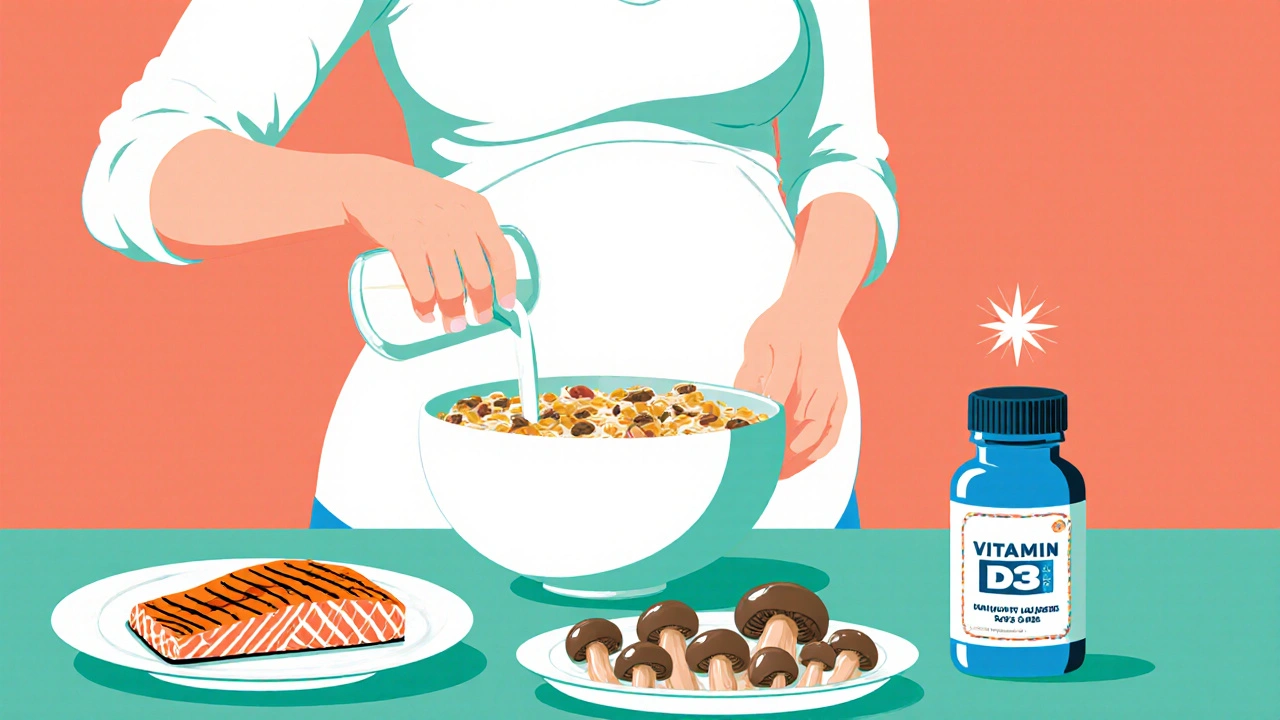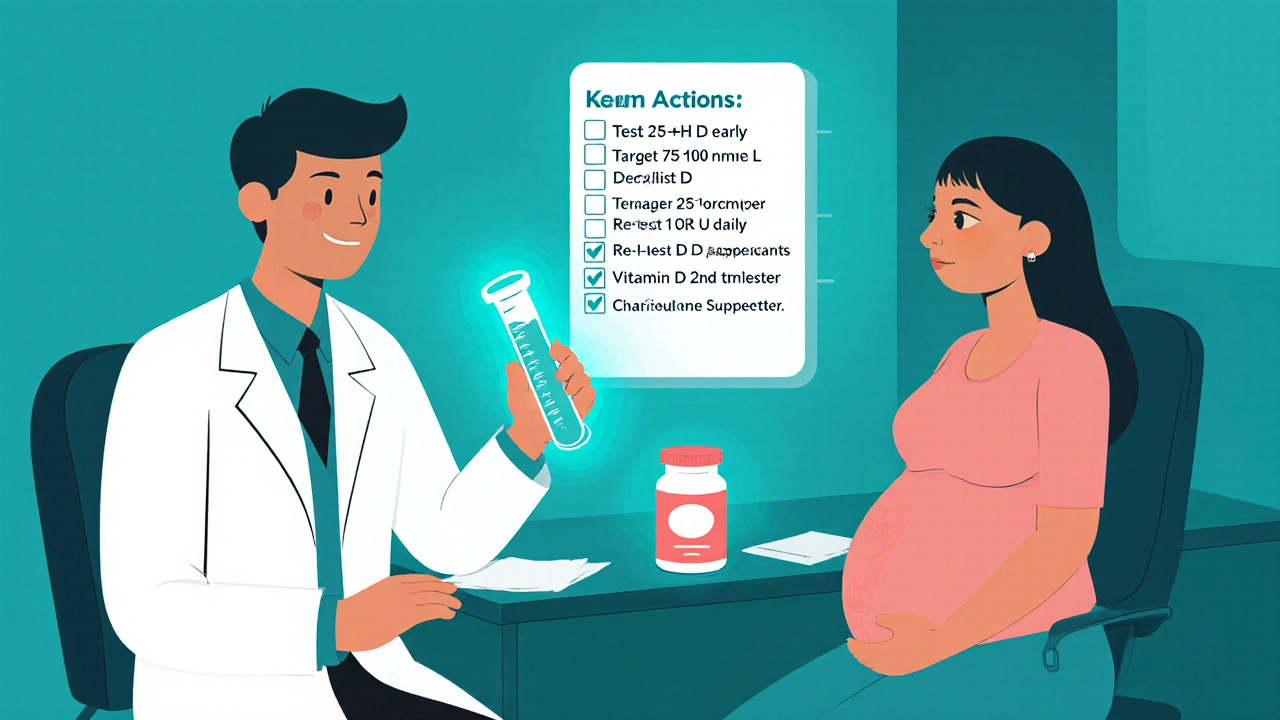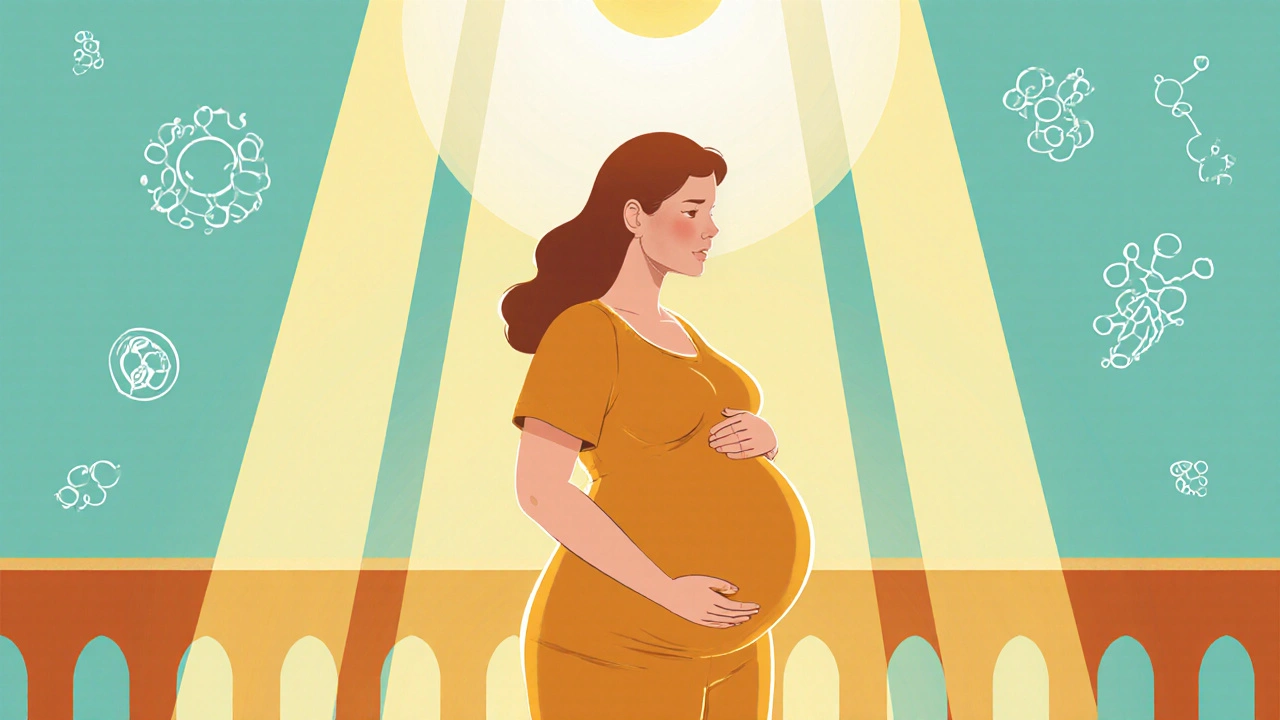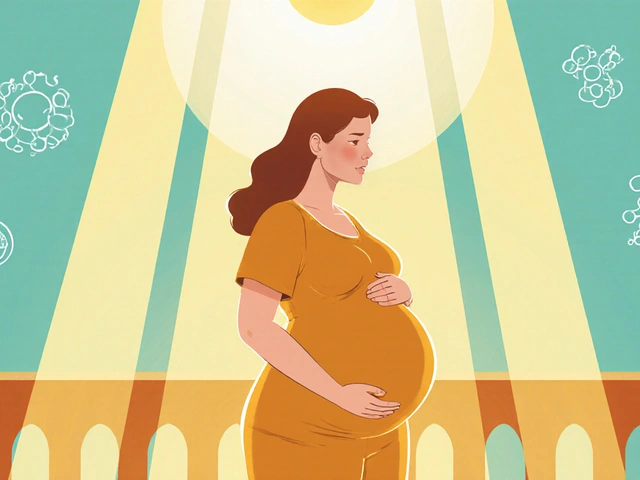Vitamin D Pregnancy Calculator
Calculate Your Vitamin D Intake
Estimate your daily vitamin D intake from food, sun exposure, and supplements. Recommended levels for pregnant women: 75-100 nmol/L (200-400 IU/day minimum).
Why It Matters
Adequate vitamin D (75-100 nmol/L) supports:
- Healthy fetal bone development
- Reduced risk of gestational diabetes
- Stronger immune system for baby
- Lower risk of pre-eclampsia
When it comes to Vitamin D is a fat‑soluble vitamin that helps the body absorb calcium and supports immune function. Expecting mothers often hear about folic acid and iron, but vitamin D is just as vital for both mom and baby. In this guide we’ll break down why vitamin D pregnancy matters, how to spot a deficiency, and practical steps to keep levels healthy throughout the nine months.
What Vitamin D Actually Does in the Body
Vitamin D isn’t a single compound; it’s a family of related molecules, the most important being D2 (ergocalciferol) and D3 (cholecalciferol). After skin exposure to sunlight or consumption of fortified foods, the liver converts it to 25‑hydroxyvitamin D (25(OH)D), the form doctors measure in blood tests. The kidneys then turn 25(OH)D into the active hormone calcitriol, which tells the intestines to pull calcium and phosphorus from food.
- Bone health: Calcitriol drives calcium into bones, preventing the softening that leads to rickets in infants or osteomalacia in adults.
- Immune regulation: It modulates white‑blood‑cell activity, lowering the risk of infections.
- Cell growth: Emerging research links adequate vitamin D to proper placental development.
Why Pregnancy Changes the Vitamin D Game
During Pregnancy is a state of rapid tissue growth, hormonal shifts, and increased nutrient demands. The placenta acts like a semi‑permeable membrane, delivering calcium to the fetus while demanding more vitamin D to keep the process smooth. If the mother’s vitamin D stores are low, the placenta can’t convert enough calcitriol, which may limit calcium transfer and affect fetal bone formation.
Studies from the Australian Longitudinal Study on Women’s Health (2019) found that women with serum 25(OH)D levels below 50 nmol/L had a 30% higher chance of delivering a baby with low birth weight. Another 2022 meta‑analysis linked maternal vitamin D deficiency to a 1.5‑fold increase in pre‑eclampsia risk.
Key Benefits for Mom and Baby
Getting enough vitamin D isn’t just about avoiding rickets. Here’s what a healthy level looks like for both parties:
- For Mom: Reduced odds of gestational diabetes, lower blood‑pressure spikes, and a smoother postpartum recovery.
- For Baby: Stronger skull and spine development, better immune readiness in the first six months, and potentially lower rates of asthma and allergies later in childhood.
How to Know If You’re Deficient
Vitamin D deficiency often flies under the radar because symptoms-fatigue, vague muscle aches, mood swings-overlap with normal pregnancy changes. The gold standard is a blood test measuring 25(OH)D. In Australia, the reference range is:
| Group | Desired Level (nmol/L) |
|---|---|
| Non‑pregnant adults | 50‑75 |
| Pregnant women | 75‑100 |
If your result falls below 75 nmol/L, your doctor will likely suggest supplementation.

Sources of Vitamin D: Sun, Food, and Supplements
Australia’s sunny climate sounds like a free pass, but sunscreen, indoor work, and winter months can cut UVB exposure dramatically. Here’s a quick rundown of where the vitamin comes from:
- Sunlight: About 10‑15 minutes of mid‑day sun on face and arms, 2-3 times per week, can generate 1,000 IU for many people. Darker skin tones need longer exposure.
- Food: Fatty fish (salmon, mackerel), fortified milk, eggs, and mushrooms exposed to UV light.
- Supplements: Prenatal vitamins often contain 400-600 IU, but many clinicians recommend 1,000-2,000 IU for pregnant women with low levels.
When choosing a supplement, look for “cholecalciferol” (vitamin D3) and ensure it’s free of excessive vitamin A, which can be harmful in pregnancy.
Practical Tips to Keep Levels Up
- Schedule a 25(OH)D test early in the first trimester.
- If you live in southern states or spend most of the day indoors, aim for a daily supplement of 1,000 IU, unless your doctor advises otherwise.
- Include fortified cereals or plant‑based milks in your breakfast; a cup often provides 100-150 IU.
- Enjoy a serving of oily fish twice a week. For vegetarians, consider UV‑treated mushrooms.
- Take your supplement with a meal that contains some fat; vitamin D is fat‑soluble and absorbs better.
Common Concerns and Myths
Myth: “Too much vitamin D can cause hypercalcemia and harm the baby.” While extremely high doses (over 10,000 IU/day) can raise calcium too far, staying within the recommended 1,000-2,000 IU range is safe and well‑studied.
Myth: “If I eat enough fish, I don’t need supplements.” Even fish‑eaters may fall short during winter months, especially if they avoid fish due to mercury concerns.
Concern: “Will sunscreen block all vitamin D production?” SPF 30 blocks roughly 95% of UVB, but brief unprotected exposure (like a quick walk to the mailbox) still yields some vitamin D. Balance skin cancer protection with short, safe sun bursts.

What the Australian Dietary Guidelines Say
The 2023 Australian Dietary Guidelines recommend 5 µg (200 IU) of vitamin D daily for pregnant and lactating women, but they also note that supplementation may be needed to reach serum levels above 75 nmol/L. Public Health Nutrition Australia (2024) suggests that up to 1,000 IU per day is safe for most pregnant women, especially in winter.
Tracking Progress: When to Re‑test
Most obstetricians advise a follow‑up 25(OH)D test at the start of the second trimester if the initial result was low. If you’re on a supplement, a repeat test after 8-10 weeks helps confirm that levels have risen into the target range.
Bottom Line Checklist
- Ask for a 25(OH)D blood test in early pregnancy.
- Target serum levels of 75‑100 nmol/L.
- Take 1,000 IU vitamin D3 daily (or as prescribed).
- Get safe sun exposure 2‑3 times a week.
- Include fortified foods and oily fish in the diet.
- Re‑test in the second trimester to ensure adequacy.
Frequently Asked Questions
Can I get enough vitamin D from sunlight alone?
In most of Australia, short periods of midday sun a few times a week are enough for people with light skin. Darker skin, high sunscreen use, or winter months usually require a supplement.
Is it safe to take high‑dose vitamin D supplements during pregnancy?
Yes, when prescribed by a healthcare professional. Doses up to 2,000 IU per day are considered safe and can correct deficiency without causing toxicity.
What foods are the best sources of vitamin D for vegetarians?
UV‑treated mushrooms, fortified plant milks, and fortified orange juice are the top vegetarian options. A daily supplement is often recommended to fill any gaps.
How does vitamin D affect my baby’s immune system?
Adequate vitamin D helps the newborn produce antimicrobial peptides, which can lower the risk of respiratory infections in the first six months.
When should I have my vitamin D levels checked?
Ideally at the first prenatal visit, and again in the second trimester if you started a supplement or had low levels initially.



Kirsten Youtsey
October 20, 2025 at 20:45Vitamin D isn’t just a trendy supplement, it’s a cornerstone of maternal skeletal integrity and fetal immunological programming. The research consistently shows that serum levels below 75 nmol/L correlate with increased risk of low‑birth‑weight infants, a statistic that mainstream health narratives tend to downplay. Moreover, the pharmaceutical lobby often promotes minimal dosing to keep the market for fortified foods thriving, a strategy that borders on manipulation. Ignoring the need for 1,000 IU daily during the second trimester is practically an endorsement of suboptimal outcomes. In short, the evidence demands a proactive supplementation regimen.
Matthew Hall
November 4, 2025 at 15:45Look, the drama of pregnancy hormones is nothing compared to the silent sabotage of inadequate vitamin D. When you’re stuck indoors under fluorescent lights, your skin can’t synthesize the hormone, and the deficiency creeps in unnoticed. The parents‑to‑be who rely solely on diet are basically walking a tightrope without a safety net. A daily supplement of 1,000 IU isn’t overkill, it’s common sense for anyone who wants a healthy baby. The whole situation feels like a conspiracy of comfort zones that keep moms guessing.
Deja Scott
November 19, 2025 at 11:45Vitamin D plays a vital role in bone mineralization for both mother and child. Proper levels support immune function and may reduce the incidence of gestational complications. Monitoring serum 25(OH)D early in pregnancy is advisable.
Natalie Morgan
December 4, 2025 at 07:45Sun offers a quick boost, but consistency matters. Aim for brief midday exposure a few times weekly and pair it with a reliable supplement.
Mahesh Upadhyay
December 19, 2025 at 03:45Vitamin D deficiency is a silent threat. It hampers calcium transfer to the fetus. It increases pre‑eclampsia risk. It can be fixed with 1,000 IU daily.